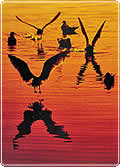 PCB's (Polychlorinated Biphenyls)
PCB's (Polychlorinated Biphenyls)
PCBs production ceased in the 1970s but they remain an important environmental threat to marine food chains and humans. PCBs are one of the most widespread and persistent man-made products in the Ecosystem. They accumulate in fatty tissues at the apex of the food chain by the ingestion of PCB contaminated foods. There is particular concern about the toxic effects of highly chlorinated PCBs in aquatic mammals and fish-eating seabirds.
What are PCBs?
- Discovered in 1865 as a liquid product of coal-tar. Manufacture began in 1927 in the USA and 1.2 million tons have been produced by several countries.
 More details
More details - Produced because of their high stability, low solubility, non-flammability and good electrical insulation qualities.
- Used widely as heat transfer fluids in transformers, capacitors, flame retardants, lubricating oils, additives in plastics and ink for carbonless copying paper.
 Structure
Structure
- There are over 70 oily synthetic compounds that are stable 800c, resistant to acids, bases, oxidants and low in solubility.
 More Info
More Info
PCBs in the environment -
- First warning in 1966 by a Swedish chemist who thought that they were a toxic hazard to the environment.
- Since then well documented environmental contamination in heavily industrialized areas such as the Great Lakes, Baltic Sea and Tokyo Bay. (2003 Symposium on PCBs -
- Found as a thin layer on the surface of coastal waters and widely in plankton, fish, and marine mammals.
 See Factsheet from Ohio State University for more details
See Factsheet from Ohio State University for more details
Sources are probably –
- spillage or leaks from large PCB containing equipment in service, in storage, or deposited in landfill sites.
- Evaporation from paints, wood preservatives, plasticizers.
- Incineration of products containing PCBs.
- Poor disposal of PCB waste. It must be burnt at high temperatures to make the emissions totally safe.
 How dangerous are PCB's?
How dangerous are PCB's?

What's your opinion?
Average rating




Not yet rated